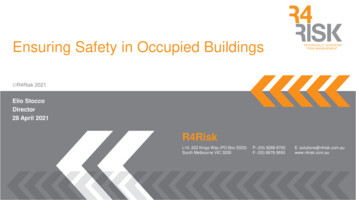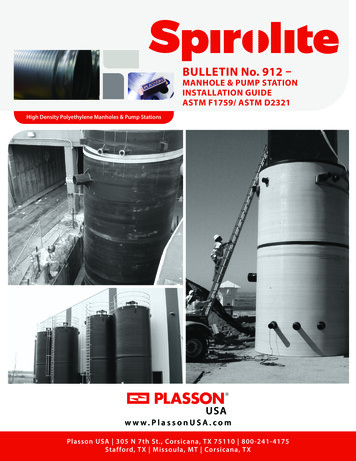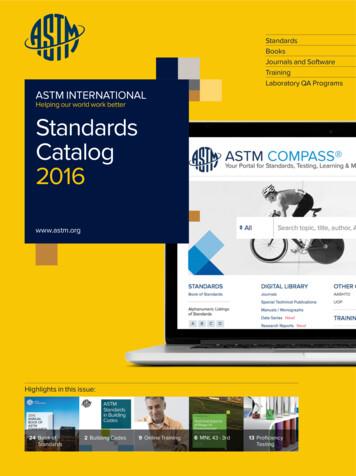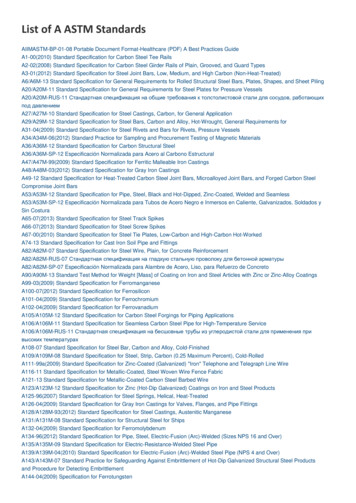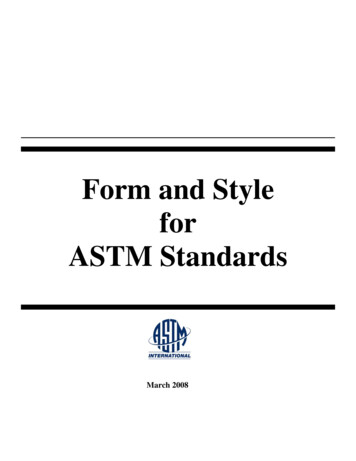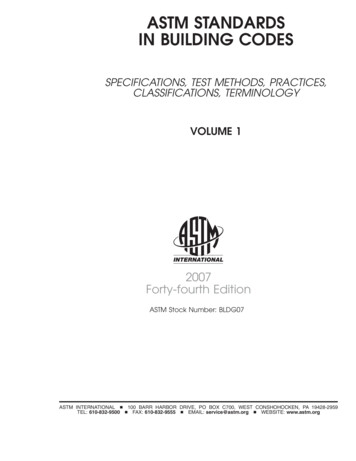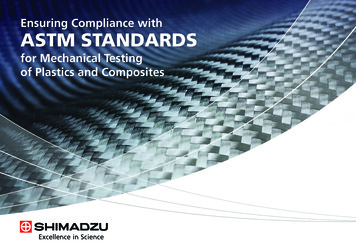
Transcription
Ensuring Compliance withASTM STANDARDSfor Mechanical Testingof Plastics and Composites
To reduce weight and increase fuel economy, aerospace andautomotive designers are increasingly using lightweight plasticsand new composite materials such as carbon fiber reinforcedplastics (CFRPs).Composite materials offer high strength with reducedweight, making them ideal for high-performance componentsfor a wide range of applications.2
Evaluating thePerformance ofComposite MaterialsThorough mechanical characterization of newplastics and composites is essential to ensureeffective modeling and the safe adoptionof these new materials in final products.ASTM standardized test methods for plasticsand CFRPs are widely used to evaluate thesenew materials. This eBook describes theuse of Shimadzu’s AGX Series Universal TestMachines to evaluate plastics and CFRPsaccording to several ASTM methods.3
CFRP ASTM Test MethodsThe performance of CFRPs depends on the fiber strength, the filling ratio ofthe carbon fibers in the resin and the orientation of the carbon fibers. For thesereasons, CFPRs exhibit highly anisotropic mechanical behavior. SpecializedASTM standard test methods have been developed to determine compositestrength under different loading orientations.Shimadzu’s AGX Series Universal Test Machines, ASTM-compliant test jigs andTrapezium X Series software provide an excellent testing platform to evaluatecomposites. Shimadzu’s TRView non-contact digital extensometer allows videocapture of tests and subsequent analysis using digital image correlation (DIC)techniques to determine strain distributions.4
V-Notched Beam Testing MethodTable 1: Test ResultsSpecimenShear Modulus(GPa)Shear Strength(MPa)Test 14.62136.0ASTM D5379 is a V-notched beam testing method used toTest 24.63133.0determine the in-plane shear properties of compositeTest 34.50131.0materials. This test method applies an asymmetrical four-pointMean4.58133.0(ASTM D5379)compression load to a sample with V notches, which enables theapplication of only shear stress on the evaluation area. This methodShear Strain Distributionis ideal for testing a variety of CFRP laminate materials, includingunidirectional, orthogonally laminated, and discontinuous fibermaterials.Results from a typical ASTM D5379 test are shown in Table 1.To obtain these measurements, an AGX Series Universal TestMachine, Trapezium X Series software and an ASTM-compliant testjig were used. The AGX Series provides multiple input channels forstrain gauges and other analog devices.Strain gauges were attached between the top and bottom Vnotches to measure strain in -45 and 45 directions (the centerof the evaluation area). The mean of the outputs obtained fromSpecimen After Testingthe strain gauges was calculated, confirming that shear strain wasbeing applied symmetrically on the front and rear of the specimen.Plastic deformationcaused by shearing5
V-Notched RailShear TestingMethodTable 2: Test ConditionsTesting MachineAGX SeriesLoad Cell50 kNTest JigASTM D7078 jigSoftwareTRAPEZIUM X Series (Single)Test Speed2 mm/min(ASTM D7078)ASTM D7078 is a V-notched railshear testing method that is widelyTable 3: Test Resultsused to determine the in-planeSpecimenShear Modulus(GPa)Shear Strength(MPa)Test 14.63121.72materials. This method uses a sampleTest 24.55120.00without holes with a large gaugeTest 34.58120.05section and can accommodate CFRPsMean4.59120.60with discontinuous fibers.Shear Strain Distributionshear characteristics of compositeShear strain can be calculated usingSpecimen After Testingthe AGX Series, TRAPEZIUM X Seriessoftware and an ASTM D7078 test jig.For this test, two strain gauges wereattached at the midpoint betweenPlastic deformationcaused by shearingthe V notches in order to measurestrain in -45 and 45 directions. Theequipment configuration is shown inTable 2. Table 3 shows that the testresults are highly reproducible.6
Open-Hole Compression TestFigure 1: Specimen(ASTM D6484)CFRPs offer a number of benefits, including specificstrength and high rigidity. However, they lose asubstantial amount of their strength when a cutout ismade. ASTM D6484 is an open-hole compression (OHC)Table 4: Test ResultsSpecimen NameOpen-Hole Compressive Strength (MPa)testing method that uses a sample with a 6 mm (0.25 inch)1st278.2diameter circular hole cut in its center.2nd273.0Mean275.6ASTM D6468 has two loading methods: Method A andMethod B. In Method B the sample is compressed usingcompression plates located on the ends of the sampleFigure 2: Stress-DisplacementCurves for Compression TestFigure 3: DICAnalysis Resultsand test fixture.A typical ASTM D6484 test sample is shown in Figure 1.ASTM D6484 Method B test results using a Shimadzu AGXSeries Test Machine and TRViewX video extensometer areshown in Table 4. The stress-displacement curves areshown in Figure 2.Figure 3 shows DIC strain distributions around the hole inthe specimen. Strain accumulated at the vertical sides ofthe open hole (regions 1 and 3), and strain appeared alongthe axis of compression from those points. The final breakoccurred at the vertical sides of the hole.7
Combined Loading Compression Test(ASTM D6641)ASTM D6641 combined loading compression (CLC) test can be used tosimultaneously evaluate compressive strength and elastic modulus. ASTM D6641may be performed with a simple jig structure and untabbed specimens.The images on the right show the test jig and a typical sample. Strain gauges areattached to the front and rear of the specimens to confirm alignment. Samplesmounted in the test jig assembly are compressed using compression plates.Typical test results obtained using a Shimadzu AGX Series Universal Test Machineand CLC test fixture are shown in Table 5.Table 5: Test ResultsCompressive Strength(MPa)Elastic Modulus(GPa)1st629.971.42nd651.474.3Mean640.772.98
Tensile Testing Methods(ASTM 3039, ASTM D638)ASTM 3039 defines procedures for thetensile testing of polymer composite samples.Rectangular test specimens (25 mm wide x 100mm long) are typically used. Tabs may be bondedto the sample ends to assist in gripping.ASTM D638 specifies methods for testing thetensile strength of plastics and calculatingtheir mechanical properties. This test methoduses dumbbell-shaped specimens with either a25 mm or 50 mm gauge length.ASTM D638 requires a test force accuracy thatmeets ASTM E4 Class 1—accuracy within 1%of the indicated test force. All of Shimadzu’s testframes and load cells meet the test force accuracyrequirements for ASTM D638.For ASTM D638, Shimadzu offers a range ofextensometer options including strain gaugeextensometers and the TRViewX non-contactdigital video extensometer.9
Flexural Testing Methods:(ASTM D790, ASTM D2344, ASTM D6272, ASTM D7264)The flexural or bending properties of plastics are important for manyapplications. Various ASTM standards describe appropriate testing procedures.Three- or four-point bending testing is used to measure the strengthproperties of comparatively rigid materials. For this type of testing, it isrecommended to directly measure the sample strain using deflection gauges orother strain gauges. The fulcrum span is determined according to the samplethickness. It is therefore important to know the range of sample dimensionsbefore selecting the test jig.ASTM D790 is a common testing method for determining the flexuralproperties of reinforced and unreinforced plastics. ASTM D790requires a testing force accuracy within 1% of theindicated test force, as specified by ASTM E4 Class 1.All of Shimadzu’s testing frames and load cells complywith the accuracy requirements of ASTM D790.In this testing method, a deflectometer is used tomeasure flexural displacements. Shimadzu offersdeflectometers that meet the testing requirementsof ASTM D790. They can be easily integrated intothe AGX Series test frames.10
Testing Solutions for ASTM StandardsShimadzu offers a comprehensive line of test frames, grips and extensometersthat meet or exceed the requirements of important ASTM testing standards.From compositional analysis to mechanical testing to inspection evaluations,we have the quality instruments you need to ensure ongoing success.To learn more about how Shimadzu can supportyour materials testing needs, visitwww.ShimadzuMaterialScience.com11
To learn more about how Shimadzu cansupport your materials testing needs, visitwww.ShimadzuMaterialScience.com7102 Riverwood Drive, Columbia, MD 21046, USAPhone: 800.477.1227 / 410.381.1227www.ssi.shimadzu.com
For ASTM D638, Shimadzu offers a range of extensometer options including strain gauge extensometers and the TRViewX non-contact digital video extensometer. 9. 1 Flexural Testing Methods: (ASTM D790, ASTM D2344, ASTM D6272, ASTM D7264) The flexural or bending properties of plastics are important for many applications. Various ASTM standards describe appropriate testing procedures. Three- or .


